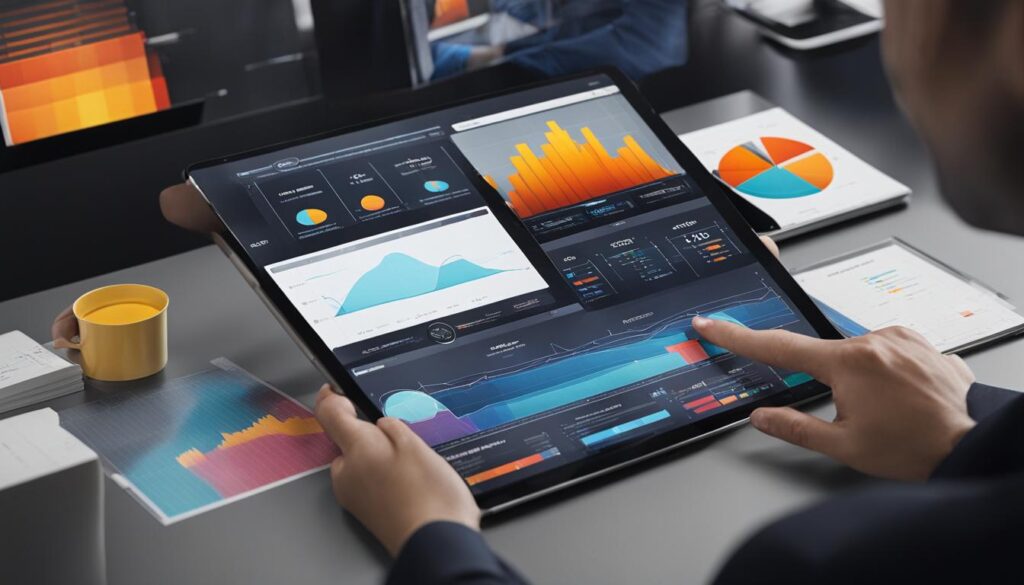Augmented reality (AR) is a technology that overlays digital content onto the real world, creating immersive and interactive experiences. Companies often wonder how they can track and monitor the usage of AR to measure its effectiveness. In this article, we will explore different methods and solutions available for tracking augmented reality usage and monitoring the impact of AR technology implementations.
Contents
- 1 Defining Goals and Methods for Tracking AR Usage
- 2 Testing and Evaluating AR Experiences
- 3 Analyzing Results and Communicating Findings
- 4 Augmented Reality Analytics and Metrics
- 5 Conclusion
- 6 FAQ
- 6.1 Can you track the usage of augmented reality?
- 6.2 How can you track augmented reality usage?
- 6.3 What methods can be used to track augmented reality usage?
- 6.4 How do you define goals for tracking augmented reality usage?
- 6.5 How do you test and evaluate augmented reality experiences?
- 6.6 How do you analyze the results of augmented reality experiences?
- 6.7 How do you communicate the findings of augmented reality analysis?
- 6.8 What role do augmented reality analytics play in tracking usage?
- 6.9 How can augmented reality metrics help measure the effectiveness of AR campaigns?
- 6.10 Can you monitor the impact of augmented reality technology implementations?
- 7 Source Links
Key Takeaways:
- Tracking the use of augmented reality is possible through various methods and solutions.
- Defining goals and choosing appropriate tracking methods are essential steps in monitoring AR usage.
- Testing and evaluating AR experiences help optimize implementations and improve user satisfaction.
- Analyzing results and communicating findings enable data-driven decisions for AR campaigns.
- Augmented reality analytics provide valuable insights into the effectiveness of AR marketing efforts.
Defining Goals and Methods for Tracking AR Usage
Before you can effectively track and monitor the usage of augmented reality (AR), it is crucial to define clear goals for your AR experience. By establishing these goals, you can establish key performance indicators (KPIs) that will help measure its success. Consider the purpose of the AR implementation, the target audience, and the desired outcomes. This will provide a solid foundation for tracking and evaluating the effectiveness of your AR experiences.
Once you have defined your goals, you can choose the appropriate methods to track the AR experience and measure its impact. Here are some methods to consider:
- Analytics: Utilize analytics tools to track user behavior within the AR experience. This includes data such as session duration, interaction frequency, and click-through rates. Analyzing this data can help you gain insights into user engagement and improve the overall AR experience.
- Surveys: Gather feedback from users through surveys to measure user satisfaction and gather insights. This allows you to understand the user’s perspective and make informed decisions for optimizing the AR implementation.
- Interviews: Conduct interviews with users to gain deeper insights into their experiences with AR. This qualitative approach provides valuable feedback and allows you to understand user sentiments, challenges, and preferences.
- Observations: Monitor user interactions and behaviors during their AR experience. This can be done through user testing sessions or by analyzing user-generated content related to the AR experience. Observations help identify any usability issues and areas for improvement.
By combining these methods, you can gather comprehensive data to track the usage of AR, measure its effectiveness, and make data-driven decisions to enhance the overall experience.
With a clear understanding of your goals and the appropriate tracking methods in place, you can optimize your AR implementation, ensure user satisfaction, and deliver impactful AR experiences.
Testing and Evaluating AR Experiences
Once you have defined your goals and chosen the methods for tracking and monitoring the usage of augmented reality (AR), it is crucial to test and evaluate your AR experience. By conducting comprehensive user testing and evaluation, you can ensure that your AR implementation delivers the desired results and meets user expectations.
There are various ways to perform user testing for AR experiences, including:
- Lab testing: In a controlled environment, users interact with your AR application or device while researchers observe and record their behavior.
- Field testing: Real-world scenarios are recreated to evaluate the AR experience in different contexts and gather user feedback.
- Remote testing: Users participate in testing sessions from their own locations, providing insights into how they engage with AR remotely.
During the testing phase, it is essential to focus on:
- Validating design decisions: Evaluate whether the AR design is intuitive, user-friendly, and aligned with your goals.
- Identifying potential issues: Discover any technical glitches, performance barriers, or usability challenges that may hinder the user experience.
- Optimizing the AR implementation: Use user feedback to refine and enhance your AR experience, ensuring it delivers maximum impact.
By incorporating user testing and evaluation into your AR development process, you can refine your assumptions, make data-driven decisions, and optimize the overall implementation for better user satisfaction and engagement.

| Benefits of User Testing and Evaluation in AR | Examples |
|---|---|
| To Validate AR Design Decisions | Ensuring that the placement and interaction of virtual objects in space align with users’ expectations |
| To Identify Usability Issues | Discovering problems, such as difficulty in navigating AR interfaces or insufficient visual cues, that impede user engagement |
| To Optimize User Experience | Using user feedback to enhance AR functionality, responsiveness, and overall satisfaction |
Testing and evaluating your AR experience is a critical step in creating impactful and successful augmented reality applications. By incorporating user feedback and refining your design, you can optimize the implementation and deliver exceptional AR experiences to your target audience.
Analyzing Results and Communicating Findings
Now that you have tested and evaluated your AR experience, it’s time to analyze the results and draw conclusions. By using quantitative and qualitative methods, you can interpret the data and feedback collected during the testing phase. This analysis will provide valuable insights into the strengths and weaknesses of your AR experience.
There are several analytical techniques you can employ to analyze the results effectively:
- Descriptive Analysis: This technique involves summarizing and describing the data collected from the AR experience. It helps you identify patterns, trends, and key metrics that can further inform your decision-making process.
- Inferential Analysis: By applying statistical methods, you can draw meaningful conclusions and make predictions based on the data collected. This analysis allows you to understand the impact of the AR experience on your target audience and its effectiveness in achieving the goals set.
- Thematic Analysis: This qualitative analysis technique involves identifying and analyzing recurring themes or patterns in the feedback and user responses. It helps uncover deeper insights into user preferences, satisfaction, and areas for improvement.
Once you have analyzed the results, it’s crucial to communicate your findings and recommendations to stakeholders and users. Effective and engaging methods of communication can include:
- Interactive visual dashboards that present the key metrics and insights in a visually appealing and easy-to-understand format.
- Written reports that provide a comprehensive overview of the analysis, including charts, graphs, and supporting data.
- Narrative stories that use storytelling techniques to convey the impact and value of the AR experience to stakeholders and users.
By effectively analyzing and communicating the findings of your AR experience, you can ensure that the insights derived from the data are utilized to optimize future AR implementations and make informed decisions that drive engagement and deliver exceptional experiences to your audience.

As you can see, analyzing results and communicating findings play a vital role in achieving success with augmented reality. It provides valuable information to stakeholders, enables data-driven decision-making, and allows continuous improvement and optimization of AR implementations. Next, let’s dive into the role of augmented reality analytics and metrics in tracking and measuring the effectiveness of AR campaigns.
Augmented Reality Analytics and Metrics
When it comes to tracking the effectiveness of your AR campaigns, augmented reality analytics are essential. These analytics provide valuable insights into the performance and impact of your AR implementations. By utilizing AR analytics, you can measure key metrics and gain a deeper understanding of your AR campaign’s success.
AR analytics allow you to track various metrics that indicate the engagement and effectiveness of your AR experiences. Some key metrics include:
- Unique users: Measure the number of individual users who engage with your AR content.
- Engagement levels: Analyze the level of interaction and engagement with your AR experiences.
- Click-through rates: Track the percentage of users who interact with calls-to-action within your AR content.
- Page views per user: Understand how many pages or screens users navigate through during their AR experience.
- Dwell time: Measure the amount of time users spend engaging with your AR content.
By comparing these metrics with other AR or non-AR campaigns, you can gain valuable insights into the impact and value of your AR marketing efforts. This allows you to make data-driven decisions and optimize your AR implementations for better results.
“AR analytics provide a wealth of valuable data that can inform your marketing strategy and enhance the effectiveness of your AR campaigns.”
Augmented reality metrics give you a deeper understanding of how users interact with your AR experiences and provide valuable insights into user behavior and preferences. By analyzing these metrics, you can identify areas for improvement, optimize your AR campaigns, and deliver more engaging and impactful experiences to your audience.
Take a look at the image below to see how AR analytics can help you measure key metrics and gain valuable insights into the effectiveness of your AR campaigns.

In conclusion, AR analytics and metrics play a vital role in monitoring and measuring the effectiveness of your AR campaigns. By tracking key metrics and analyzing the data, you can optimize your AR implementations and deliver captivating experiences to your audience.
Conclusion
Tracking and monitoring augmented reality (AR) usage is essential for businesses looking to measure the impact of their AR technology implementations. By defining clear goals, testing and evaluating experiences, analyzing results, and utilizing augmented reality analytics, companies can effectively track and measure the usage of AR.
Defining goals for your AR experience is the first step in tracking its usage. Consider the purpose of the implementation, the target audience, and the key performance indicators (KPIs) that will determine its success. This will enable you to choose the most appropriate methods for collecting and analyzing data, such as analytics, surveys, interviews, and observations.
Testing and evaluating your AR experiences is crucial to optimizing their implementation. Through user testing, you can validate design decisions, identify any issues, and ensure that your AR experience delivers the desired results. Thorough testing and evaluation allow you to make data-driven decisions and provide engaging and impactful AR experiences to your users.
Finally, analyzing the results and communicating your findings are vital steps in tracking AR usage. By utilizing both quantitative and qualitative methods, such as descriptive and inferential analysis, you can gain insights into the strengths and weaknesses of your AR implementation. Effective communication with stakeholders and users, through visual dashboards, reports, or narratives, ensures that your findings and recommendations are understood and acted upon.
FAQ
Can you track the usage of augmented reality?
Yes, it is possible to track and monitor the usage of augmented reality. By implementing appropriate methods and solutions, businesses can measure the effectiveness of their AR implementations.
How can you track augmented reality usage?
To track augmented reality usage, it is important to define your goals, choose appropriate methods for data collection, and analyze the results. Augmented reality analytics can also provide insights into the impact and value of AR marketing efforts.
What methods can be used to track augmented reality usage?
Methods for tracking augmented reality usage can include analytics to track user behavior, surveys to measure user satisfaction, interviews to gain insights, and observations to monitor user interactions.
How do you define goals for tracking augmented reality usage?
Defining goals for tracking augmented reality usage involves considering the purpose of the AR implementation, the target audience, and the key performance indicators that will measure its success.
How do you test and evaluate augmented reality experiences?
Augmented reality experiences can be tested and evaluated through methods such as lab testing, field testing, and remote testing. These tests help validate design decisions, identify issues, and optimize the AR implementation for better user experience.
How do you analyze the results of augmented reality experiences?
Results of augmented reality experiences can be analyzed using quantitative and qualitative methods. Analytical techniques such as descriptive analysis, inferential analysis, and thematic analysis help understand the strengths and weaknesses of the AR experience.
How do you communicate the findings of augmented reality analysis?
The findings and recommendations from augmented reality analysis can be communicated to stakeholders and users using methods such as interactive visual dashboards, written reports, or narrative stories.
What role do augmented reality analytics play in tracking usage?
Augmented reality analytics help track unique users, engagement levels, click-through rates, page views per user, dwell time, and other metrics that indicate the success of an AR implementation. Comparing these metrics with other AR or non-AR campaigns provides insights into the impact and value of AR marketing efforts.
How can augmented reality metrics help measure the effectiveness of AR campaigns?
Augmented reality metrics provide valuable data to measure the effectiveness of AR campaigns. Metrics such as user engagement, interaction rates, and conversion rates help businesses understand the impact and value of their AR marketing efforts.
Can you monitor the impact of augmented reality technology implementations?
Yes, it is possible to monitor the impact of augmented reality technology implementations. By tracking and measuring AR usage, companies can optimize their AR implementations, make data-driven decisions, and deliver engaging and impactful AR experiences to their users.




